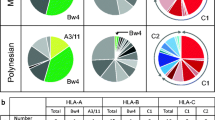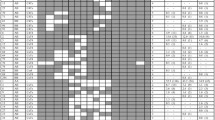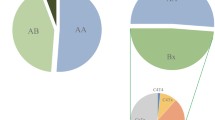Abstract
Killer immunoglobulin-like receptors (KIRs) regulate the activity of NK and T cells through interaction with specific HLA class I molecules on target cells. To date, 16 KIR genes and pseudogenes have been identified. Diversity in KIR gene content and KIR allelic and haplotype polymorphism has been observed between different ethnic groups. Here, we present data on the KIR gene distribution in Pacific Islands populations. Sixteen KIR genes were observed in Pacific Islands populations from the Cook Islands, Samoa, Tokelau, and Tonga. The majority of KIR genes were present at similar frequencies between the four populations with KIR2DL4, KIR3DL2, and KIR3DP1 genes observed in all individuals. Commonly observed KIR genes in Pacific Islands populations (pooled frequencies) were KIR2DL1 (0.77), KIR2DL3 (0.77), KIR3DL1 (0.65), KIR3DL3 (0.93), KIR2DS4/1D (0.78), and KIR2DP1 (0.82), compared to the less-frequently observed KIR2DL2 (0.27), KIR2DL5 (0.30), KIR2DS1 (0.19), KIR2DS2 (0.27), KIR2DS3 (0.16), KIR2DS5 (0.17), and KIR3DS1 (0.18) genes. Differences in KIR gene frequency distributions were observed between the Pacific Islands populations and when compared to other populations. Sixty-nine different genotypes were identified, with five genotypes accounting for more then 50% of all genotypes observed. The number of genotypes observed in each population was similar in the Cook Islands, Samoan, and Tokelauan populations (19, 18, and 19, respectively), but 26 different genotypes were observed in Tongans. The putative haplotype A was predominantly observed over haplotype B in all Pacific Islands populations. Significant linkage disequilibrium was observed for a number of KIR gene pairs.



Similar content being viewed by others
References
Bellwood P (1987) The archaeological origins of the Polynesians. In: The Polynesians. Thames and Hudson, London, pp 45–66
Biassoni R, Pessino A, Malaspina A, Cantoni C, Bottino C, Sivori S, Moretta A (1997) Role of amino acid position 70 in the binding affinity of p50.1 and p58.1 receptors for HLA-Cw4 molecules. Eur J Immunol 27:3095–3099
Boyington JC, Sun PD (2002) A structural perspective on MHC class I recognition by killer cell immunoglobulin-like receptors. Mol Immunol 38:1007–1021
Cavalli-Sforza L, Menozzi P, Piazza A (1994) Australia, New Guinea and the Pacific Islands. In: The history and geography of human genes. Princeton University Press, Princeton, pp 343–371
Colonna M, Borsellino G, Falco M, Ferrara GB, Strominger JL (1993) HLA-C is the inhibitory ligand that determines dominant resistance to lysis by NK1- and NK2-specific natural killer cells. Proc Natl Acad Sci USA 90:12000–12004
Cook MA, Norman PJ, Curran MD, Maxwell LD, Briggs DC, Middleton D, Vaughan RW (2003) A multi-laboratory characterisation of the KIR genotypes of 10th international histocompatibility workshop cell lines. Hum Immunol 64:567–571
Denis L, Sivula J, Gourraud PA, Kerdudou N, Chout R, Ricard C, Moisan JP, Gagne K, Partanen J, Bignon JD (2005) Genetic diversity of KIR natural killer cell markers in populations from France, Guadeloupe, Finland, Senegal and Reunion. Tissue Antigens 66:267–276
Dohring C, Sceidegger D, Samaridis J, Cella M, Colonna M (1996) A human killer inhibitory receptor specific for HLA-A1, 2. J Immunol 156:3096–3101
Dupont B, Selvakumar A, Steffens U (1997) The killer cell inhibitory receptor genomic region on human chromosome 19q13.4. Tissue Antigens 49:557–563
Felsenstein J (2004) PHYLIP (Phylogeny Inference Package) version 3.6. University of Washington, Seattle (distributed by the author)
Flint J, Boyce AJ, Martison JJ, Clegg JB (1989) Population bottlenecks in Polynesia revealed by minisatellites. Hum Genet 83:257–263
Gaudieri S, Nolan D, McKinnon E, Witt C, Mallal S, Christiansen FT (2005) Associations between KIR epitope combinations expressed by HLA-B/-C haplotypes found in an HIV-1 infected study population may influence NK mediated immune response. Mol Immunol 42:557–560
Geggus D (2001) The French slave trade: an overview. William Mary Q 58:119–138
Gibbons A (2001) The peopling of the Pacific. Science 291:1735–1737
Gomez-Lozano N, Vilches C (2002) Genotyping of human killer-cell immunoglobulin-like receptor genes by polymerase chain reaction with sequence-specific primers: an update. Tissue Antigens 59:184–193
Gumperz JE, Litwin V, Phillips JH, Lanier LL, Parham P (1995) The Bw4 epitope of HLA-B molecules confers reactivity with natural killer cell clones that express NKB1, a putative HLA receptor. J Exp Med 181:1133–1144
Hsu KC, Chida S, Geraghty DE, Dupont B (2002a) The killer cell immunoglobulin-like receptor (KIR) genomic region: gene-order, haplotypes and allelic polymorphism. Immunol Rev 190:40–52
Hsu KC, Liu XR, Selvakumar A, Mickelson E, O’Reilly RJ, Dupont B (2002b) Killer Ig-like receptor haplotype analysis by gene content: evidence for genomic diversity with a minimum of six basic framework haplotypes, each with multiple subsets. J Immunol 169:5118–5129
Jiang K, Zhu FM, Lv QF, Yan LX (2005) Distribution of killer cell immunoglobulin-like receptor genes in the Chinese Han population. Tissue Antigens 65:556–563
Keclard L, Romana M, Lavocat E, Saint-Martin C, Berchel C, Merault G (1997) Sickle cell disorder, beta-globin gene cluster haplotypes and alpha-thalassemia in neonates and adults from Guadeloupe. Am J Hematol 55:24–27
Khakoo SI, Thio CL, Martin MP, Brooks CR, Gao X, Astemborski J, Cheng J, Goedert JJ, Vlahov D, Hilgartner M, Cox S, Little AM, Alexander GJ, Cramp ME, O’Brien SJ, Rosenberg WMC, Thomas DL, Carrington M (2004) HLA and NK cell inhibitory receptor genes in resolving hepatitis C virus infection. Science 305:872–874
Leung W, Iyengar R, Turner V, Lang P, Bader P, Conn P, Niethammer D, Handgretinger R (2004) Determinants of antileukemia effects of allogeneic NK cells. J Immunol 172:644–650
Lewontin RC (1964) The interactions of selection and linkage. Genetics 49:49–67
Long EO (1999) Regulation of immune responses through inhibitory receptors. Annu Rev Immunol 17:875–904
Luszczek W, Manczak M, Cislo M, Nockowski P, Wisniewski A, Jasek M, Kusnierczyk P (2004) Gene for the activating natural killer cell receptor, KIR2DS1, is associated with susceptibility to psoriasis vulgaris. Hum Immunol 65:758–766
Mack SJ, Bugawan TL, Moonsamy PV, Erlich JA, Trachtenberg EA, Paik YK, Begovich AB, Saha N, Beck HP, Stoneking M, Erlich HA (2000) Evolution of Pacific/Asian populations inferred from HLA class II allele frequency distribution. Tissue Antigens 55:383–400
Marsh SGE, Parham P, Dupont B, Geraghty DE, Trowsdale J, Middleton D, Vilches C, Carrington M, Witt C, Guethlein LA, Shilling H, Garcia CA, Hsu KC, Wain H (2003) Killer-cell immunoglobulin-like receptors (KIR) Nomenclature Report, 2002. Immunogenetics 55:220–226
Martin AM, Freitas EM, Witt CS, Christiansen FT (2000) The genomic organization and evolution of the natural killer immunoglobulin-like receptor (KIR) gene cluster. Immunogenetics 51:268–280
Mattiuz PL, Ihde D, Piazza A, Ceppellini R, Bodmer WF (1971) New approaches to the population genetic and segregation analysis of the HLA system. In: Terasaki PI (ed) Histocompatibility testing. Munksgaard, Kopenhagen
Maude HE (1981) Slavers in paradise; the Peruvian labour trade in Polynesia, 1862–1864. Australian National University Press, Canberra, p 73
Nelson GW, Martin MP, Gladman D, Wade J, Trowsdale J, Carrington M (2004) Heterozygote advantage in autoimmune disease: hierarchy of protection/susceptibility conferred by HLA and killer Ig-like receptor combinations in psoriatic arthritis. J Immunol 173:4273–4276
Niokou D, Spyropoulou-Vlachou M, Darlamitsou A, Stravropoulos-Giokas C (2003) Distribution of killer cell immunoglobulin-like receptors in the Greek population. Hum Immunol 64:1167–1176
Norman PJ, Stephens HA, Verity DH, Chandanayingyong D, Vaughan RW (2001) Distribution of natural killer cell immunoglobulin-like receptor sequences in three ethnic groups. Immunogenetics 52:195–205
Norman PJ, Carrington CV, Byng M, Maxwell LD, Curran MD, Stephens HA, Chandanayingyong D, Verity DH, Hameed K, Ramdath DD, Vaughan RW (2002) Natural killer cell immunoglobulin-like receptor (KIR) locus profiles in African and South Asian populations. Genes Immun 3:86–95
Rajagopalan S, Long EO (1999) A human histocompatibility leukocyte antigen (HLA)-G-specific receptor expressed on all natural killer cells. J Exp Med 189:1093–1100
Rajalingam R, Krausa P, Shilling HG, Stein JB, Balamurugan A, McGinnis MD, Cheng NW, Mehra NK, Parham P (2002) Distinctive KIR and HLA diversity in a panel of North Indian Hindus. Immunogenetics 53:1009–1019
Ruggeri L, Capanni M, Urbani E, Perruccio K, Shlomchik WD, Tosti A, Posati S, Rogaia D, Frassoni F, Aversa F, Martelli MF, Velardi A (2002) Effectiveness of donor natural killer cell alloreactivity in mismatched hematopoietic transplants. Science 295:2097–2100
Selvakumar A, Steffens, U Dupont B (1996) NK cell receptor gene of the KIR family with two Ig domains but highest homology to KIR receptors with three domains. Tissue Antigens 48:285–294
Shilling HG, Young N, Guethlein LA, Cheng NW, Gardiner CM, Tyan D, Parham P (2002) Genetic control of human NK repertoire. J Immunol 169:239–247
Toneva M, Lepage V, Lafay G, Dulphy N, Busson M, Lester S, Vu-Trien A, Michaylova A, Naumova E, McCluskey J, Charron D (2001) Genomic diversity of natural killer cell receptor genes in three populations. Tissue Antigens 57:358–362
Uhrberg M, Valiante NM, Shum BP, Shilling HG, Lienert-Weidenbach K, Corliss B, Tyan D, Lanier LL, Parham P (1997) Human diversity in killer cell inhibitory receptor genes. Immunity 7:753–763
Uhrberg M, Parham P, Wernet P (2002) Definition of gene content for nine common group B haplotypes of the Caucasoid population: KIR haplotypes contain between seven and eleven KIR genes. Immunogenetics 54:221–229
Valiante NM, Uhrberg M, Shilling HG, Liener-Weidenbach K, Arnett KL, D’Andrea A, Phillips JH, Lanier LL, Parham P (1997) Functionally and structurally distinct NK cell receptor repertoires in peripheral blood of two donors. Immunity 7:739–751
Velickovic ZM, Carter JM (2001) HLA-DPA1 and DPB1 polymorphism in four Pacific Islands populations determined by sequencing based typing. Tissue Antigens 57:493–501
Velickovic ZM, Delahunt B, Carter JM (2002) HLA-DRB1 and HLA-DQB1 polymorphisms in Pacific Islands populations. Tissue Antigens 59:397–406
Vilches C, Parham P (2002) KIR Diverse, rapidly evolving receptors of innate and adaptive immunity. Annu Rev Immunol 20:217–251
Whang DH, Park H, Yoon JA, Park MH (2005) Haplotype analysis of killer cell immunoglobulin-like receptor genes in 77 Korean families. Hum Immunol 66:146–154
Williams F, Meenagh A, Sleator C, Cook D, Fernandez-Vina M, Bowcock AM, Middleton D (2005) Activating killer cell immunoglobulin-like receptor gene KIR2DS1 is associated with psoriatic arthritis. Hum Immunol 66:836–841
Wilson MJ, Torkar M, Trowsdale J (1997) Genomic organization of a human killer cell inhibitory receptor gene. Tissue Antigens 49:574–579
Witt CS, Dewing C, Sayer DC, Uhrberg M, Parham P, Christiansen FT (1999) Population frequencies and putative haplotypes of the killer cell immunoglobulin-like receptor sequences and evidence for recombination. Transplantation 68:1784–1789
Yawata M, Yawata N, McQueen KL, Cheng NW, Guethlein LA, Rajalingam R, Shilling HG, Parham P (2002) Predominance of group A KIR haplotypes in Japanese associated with diverse NK cell repertoires of KIR expression. Immunogenetics 54:543–550
Acknowledgements
The authors would like to thank the participating Pacific Islands communities and volunteers.
Author information
Authors and Affiliations
Corresponding author
Rights and permissions
About this article
Cite this article
Velickovic, M., Velickovic, Z. & Dunckley, H. Diversity of killer cell immunoglobulin-like receptor genes in Pacific Islands populations. Immunogenetics 58, 523–532 (2006). https://doi.org/10.1007/s00251-006-0124-3
Received:
Accepted:
Published:
Issue Date:
DOI: https://doi.org/10.1007/s00251-006-0124-3




